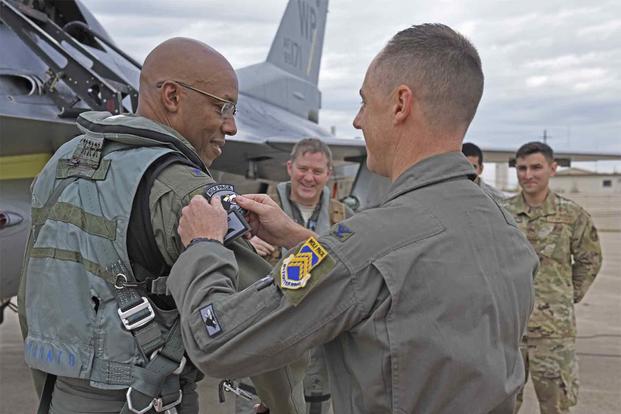Confronting drops in interest in joining the military among Black men, Hispanic men, and women in the past few years, Air Force leadership is trying to combat hesitancy with an aggressive push to show that the service has opportunities for all.
That starts with developing more diversity in its leadership, as well as the ranks of pilots and airmen in the operational career fields that often produce the service's top brass.
If the Air Force is going to grow a cadre of leaders that looks more like America, Chief of Staff Gen. Charles "CQ" Brown said Wednesday, it's first going to have to show young airmen from racial minorities and female airmen that these jobs can be open to them -- before they even put on a uniform.
"Young people only aspire to be what they can see," Brown said in a roundtable with reporters at the Air Force Association's Air Space & Cyber conference in National Harbor, Maryland. "If they don't see someone that looks like them in a higher position, or they have not had an opportunity to experience it, then they're less inclined to do so."
Brown, who is the first Black service chief in U.S. military history, pointed to his own background as an example. He said he planned to become an engineer when he joined the Air Force. That changed the day he got to fly in a T-37 training airplane. His career goals quickly shifted, and he went on to become an F-16 Fighting Falcon pilot.
But the racial turmoil of recent years -- particularly the military's involvement in responding to protests following the death of George Floyd -- has dealt a blow to the Air Force's ability to recruit people of color, Maj. Gen. Ed Thomas, commander of the Air Force Recruiting Service, said at an earlier roundtable discussion Wednesday.
"There's no doubt," he said. "The data shows us that the racial division in our nation has done damage to our recruiting efforts."
In a particularly concerning sign, Thomas said, Defense Department research has shown that the biggest drops in interest in serving in the military have come from the populations of Black men, Hispanic men, and women.
But Thomas hopes that things will improve in the future. Floyd's death pushed the Air Force to renew its focus on addressing racial issues and reaching out to underserved populations, he said.
"While it has done damage in the short term, I'm optimistic that in the long term, we will end up being better for it," he said. "But it's only going to be with a lot of hard work to get us there."
One area of increasing concern in recent years has been the differences in the way women and airmen who are from racial minorities are treated in promotions, leadership opportunities and chances for career advancement compared to their white and male counterparts. The Air Force's inspector general has released two reports since last December outlining the ways in which disparities have emerged.
The service is looking for ways to adjust its systems to correct those imbalances. A recent change to the Air Force's promotion system has helped increase promotion rates for diverse groups of officers, Brown said.
The service, in 2019, broke up its massive Line of the Air Force promotion group -- which at one point represented about 87% of active-duty officers, including pilots -- into six smaller, more specialized career field categories.
Pilots tended to do better under the old system, because the criteria for promotion often favored their operational, leadership and career development experience. And because pilots historically are more likely to be white and male, that contributed to the racial differences in promotions highlighted in that pair of recent inspector general reports.
Under the new system, officers compete for promotions against others in similar jobs. For example, pilots now go up for promotion in the air operations and special warfare group. And maintenance, logistics and security forces officers are evaluated as part of the combat support group.
That's an important step forward, Brown said, but he added that the Air Force still needs to do more to open up operational opportunities for all airmen.
He highlighted the Flight Academy Scholarship Program, which allows Air Force Junior Reserve Officer Training Corps cadets to attend accredited private pilot license training programs, as a potential way to further diversify the ranks of pilots over time.
These 230 scholarships, which were valued at about $22,500 apiece this year, cover the cost of cadets' transportation, room and board, academics and flight hours to help them earn their private pilot's licenses during an eight-week summer program.
The Flight Academy program aims to help give young people who might not otherwise have the opportunity a chance to fly. In a January news release about the program, the Air Force said that 43% of its JROTC cadets are women and 57% are members of racial minority groups. Roughly half of Air Force JROTC programs are also in inner city, rural or other socioeconomically challenged areas.
And if a cadet who attends one of these aviation programs decides to continue into the Air Force, those flight hours will give them a boost in the pilot selection process.
The Air Force is looking at other ways to increase diversity in the ranks.
Thomas also said that having female and minority recruiters will be important to help fill diversity gaps in pilot and operational career fields.
"We promote pilots," he said. "We promote navigators. We promote folks who are in the operations ranks. And to help counsel those minorities, females, others, that these are real opportunities, we want them to be able to see themselves in these roles."
-- Stephen Losey can be reached at stephen.losey@military.com. Follow him on Twitter @StephenLosey.
Related: Air Force Watchdog Finds Career Disparities for Hispanic, Asian, Female Service Members












